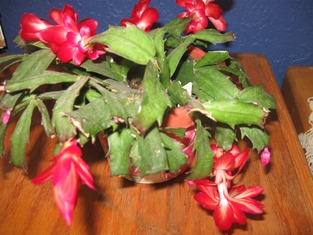Decorate for the Holidays with Christmas Cactus
There’s something extra special about growing a houseplant named after a holiday. Especially a plant like Christmas cactus, which lives up to its name by producing eye-catching blooms that rival decorations any day.
Botanically known as Schlumbergera, the Christmas cactus is an easy-to-grow plant that is native to the jungles of Brazil where it grows on trees. The plant features scallop-edged, flat, succulent type foliage and gorgeous flowers in a variety of bright colors, including pink, orange, red, white, peach and purple. Some Christmas cactus grow upright, but many drape, which makes them ideal hanging basket plants.

(Photo, Julie Bawden-Davis)
Provide ideal indoor growing conditions, and Christmas cactus will bloom every year from late November into early January. To have luck growing Schlumbergera, keep the following growing tips in mind.
Provide Cool Conditions
Christmas cactus requires the coolest room in your home. Excessive warmth may cause bud or flower drop. Place plants away from heating ducts.
Grow in Bright Light
Put Christmas cactus in a bright location, such as in front of an unobstructed eastern or southern window. They also do well under full-spectrum lighting.
Water Infrequently
Overwatering will quickly kill Christmas cactus. Even slight overwatering can cause the buds or flowers to drop. Water when the soil dries out, and don’t water when the plant is budded up and in bloom.

(Photo, Julie Bawden-Davis)
Fertilize Regularly
Christmas cactus requires fertilizing when they’re in bloom. Apply a dilute solution of an organic liquid fertilizer every time you water. When the plant isn’t blooming, don’t fertilize.
Provide Dark Nights in the Fall
In order to bloom, Schlumbergera requires 10 to 12 hours of darkness per day beginning in September. This darkness causes buds to initiate. At night, put the plant in a room that stays dark all night, or if necessary, in a closet. Once the plant buds up, avoid moving it, as the buds may fall off.
Prune After Blooming
Following blooming, prune to keep the cactus growing bushy. Twist off the leaves at the first or second joint. Doing this will create a fuller plant. It’s not necessary to prune hanging basket plants unless they’re getting too long. Wait until a plant is at least three years old before pruning.

(Photo, Monte Bawden-Grandma Beanie’s Christmas Cactus)
6Repotting Christmas Cactus
When the plant becomes root-bound, repot in a container that has drainage holes in a damp mix of 50 percent peat moss; 40 percent perlite and 10 percent worm compost. Always transplant in a pot that is no more than 2 inches bigger than the former container.
Watch for Pests
Christmas cactus occasionally gets scale insects or mealybugs. Treat both by spraying the plant with isopropyl (rubbing) alcohol. Then wait about a half hour and rinse the pests off. If the plant is flowering, just spray without rinsing.
Have Patience
My Grandma Beanie, whose Christmas cactus is pictured here, finds that her cactus isn’t always a reliable bloomer. When it does bud up for the holidays, though, as you can tell by the picture above, it’s a show stopper.





